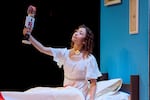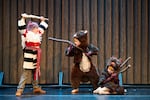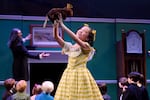
In this photo provided by Columbia Dance from 2021, dancer Sophia Yan holds up a nutcracker in a production of "The Nutcracker." Columbia Dance is premiering a new rendition of the classic ballet for the 2022 performance season, set in Fort Vancouver.
Courtesy Troy Wayrynen
Becky Moore, the director of the dance school Columbia Dance in Vancouver, Washington, loves Tchaikovsky’s classic holiday ballet “The Nutcracker” but she worries it hasn’t aged gracefully.
“The Nutcracker is 130 years old and anything that’s 130 years old comes with baggage,” says Moore. “I thought, ‘Why drag that baggage into the next 20 years?’”
Moore is quick to point out that countless productions of “The Nutcracker” are staged all over the world. For many children, Moore says, this is the first ballet they’ll perform.
But in recent years, critics of the story have called out the traditional ballet for its depictions of Asian stereotypes.
In 2017, New York City Ballet dancers Phil Chan and Georgina Pazcoguin founded Final Bow for Yellowface, a national campaign pledging to remove outdated portrayals of Asians and foster a more inclusive space in ballet. They cite “The Nutcracker” as an example of perpetuating orientalism in dance.
The original tale follows a young European girl named Clara. She dreams about a toy nutcracker that comes to life on Christmas Eve. Together they go on magical adventures to battle the evil Rat King and his mouse minions.
Along the way, she travels to the Land of the Sweets under the rule of the Sugar Plum Fairy, where she tastes wondrous treats from all across the world, including Spain, the Middle East and Asia.
“Every company, every school does a slightly different rendition,” says Moore. “Over the years, there’ve been elements of those renditions that have become seen as offensive or cultural appropriation.”
Moore specifically points to a dance in the ballet’s second act called “Chinese Tea,” where the dancers perform in stereotypical Chinese clothing such as silk dresses and bamboo hats and, in some cases, wear stereotypical Asian makeup.
“In the last few years, the kids felt really uncomfortable being someone without any Chinese heritage being cast in the Chinese dance.”
Many dance companies have updated their performances to address these problems, and now Moore believes it’s her company’s turn.
In 2019, Moore took the reins as Columbia Dance’s director. One of the first items on her agenda was to update the company’s production of “The Nutcracker” with the aim to highlight Vancouver’s diversity.
She researched Fort Vancouver’s role as a major trading post during the height of the fur trade and quickly fell in love with this history.
“You had folks coming over the Oregon Trail. You had the Indigenous populations here. You had people coming down from French Canada to trap beavers, people coming from the Hawaiian Islands to trap beavers,” she says. “The main character dreams of getting outside of her normal world and exploring something she’s never been to before. So why not have her explore this world of 1840s Fort Vancouver?”
Moore changed the main character from a European daughter of aristocrats to an American daughter of James Douglas, the real life chief trader at Fort Vancouver.
She turned the iconic nutcracker into a fur trapper and the mice into beavers.
“I fell in love with the beavers,” she says. “I’ve never been a fan of mice and they’re in every Nutcracker. I thought let’s choose a new rodent and this one is so Pacific Northwest centric.”

Young dance students at Columbia Dance in Vancouver rehearse "The Nutcracker" in 2021.
Courtesy Troy Wayrynen
Moore also learned more about Native American cultures from several of Washington’s Indigenous communities including the Cowlitz Indian Tribe, the Chinook Indian Nation and the Confederated Tribes of the Grande Ronde.
Tribal leaders taught her about important resources like the wapato plant, a staple in the diets of many Indigenous communities.
“They said the Indigenous women would wade into the pond and loosen the bulb of the plant with their feet and it would float to the surface,” she says. “As a ballet dancer, that idea of loosening something with your foot, that’s ballet! We could do that!”
Moore took extra care not to appropriate elements of Indigenous culture and ritual.
“I’m not gonna take my students and dress them up and say: ‘You are now an Indigenous person.’ That just wouldn’t feel right. But I can say you are now a dancing wapato plant.”
Despite setting the ballet in a real place like Fort Vancouver, Moore says that the show is, at its core, an imaginary fairy tale and not a documentary.
Finding a way to balance both history and fantasy in a way that made sense and be entertaining was a delightful challenge.
“Our kids want to be the beavers! I had to make a new beaver costume this year because I had a few more kids and I thought someone’s gonna get really upset if they don’t get to be a beaver!” she says. “It’s been an amazing vessel for Columbia Dance to interact with our community at large. And our mission is to enrich lives through dance and that is both through the students who come into our studios to train with us, but also to the community.”
Columbia Dance tested the first act of its new ballet in December 2021. This year, the full production debuts this weekend at the Skyview High School Concert Hall and runs through Sunday.

In this provided photo from 2021, Liya Zhao holds up a beaver doll in a new rendition of the classic ballet "The Nutcracker," set in 1840s Fort Vancouver.
Courtesy Troy Wayrynen
